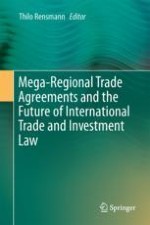2017 | OriginalPaper | Chapter
Safeguarding Public Welfare? Intellectual Property Rights, Health and the Evolution of Treaty Drafting in International Investment Agreements
Author : Bryan Mercurio
Published in: Mega-Regional Trade Agreements
Publisher: Springer International Publishing
Activate our intelligent search to find suitable subject content or patents.
Select sections of text to find matching patents with Artificial Intelligence. powered by
Select sections of text to find additional relevant content using AI-assisted search. powered by
